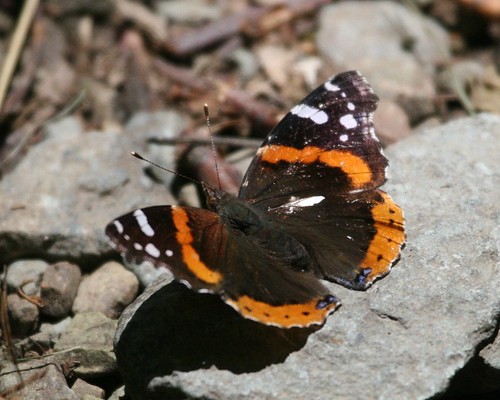
Red Admiral
While walking up Keyser Run Fire Road (which, in some maps, is named Jinny Gray Road), it seemed like there was always one of these black butterflies with an orange stripe on their wings fluttering about. I managed to get this photo while one paused on a rock by the trail. Some searching on Google led me to decide that I had taken a picture of a Red Admiral.


Gypsy Moth Mayhem
While hiking the Sugarloaf Trail, Tammy and I kept getting tricked into thinking it was about to rain. The occasional clouds that obscured the sun, and being under the canopy of trees, caused the light to sometimes dim as if rain clouds were rolling in. And then we would notice the sound of what we thought were raindrops falling through the trees. But then the sun would come back out, and that sound of raindrops would persist. And we never felt a single raindrop.
So we focused on that sound and decided that it was like a really, really slow rain. Almost like the rain on the very edge of a storm. Since nothing was wet and it was really more sunny than cloudy, we knew it could not be rain. But that sound of something falling through the leaves was always there.
When we later stopped to examine some caterpillars on the side of the trail, we finally put two and two together. There were lots of caterpillars. At first, I was assuming these were Eastern Tent Caterpillars, but after some searching on Google, a bit of reading (here and here) and some picture comparisons, I have decided that these were Gypsy Moth Caterpillars. The Gypsy Moth is an introduced species in North America. We have Étienne Léopold Trouvelot, and his fleeting interest in entomology, to thank for this.
The caterpillars were happily munching on leaves. Everywhere you looked you saw caterpillars on leaves, and the leaves had holes in them or giant chunks missing from them. And when you examined the trail closely, you noticed bits of green leaves everywhere. Our conclusion was that the massive number of Gypsy Moth Caterpillars were chowing down on the leaves in the canopy, and an endless stream of leaf pieces were falling down to the ground.

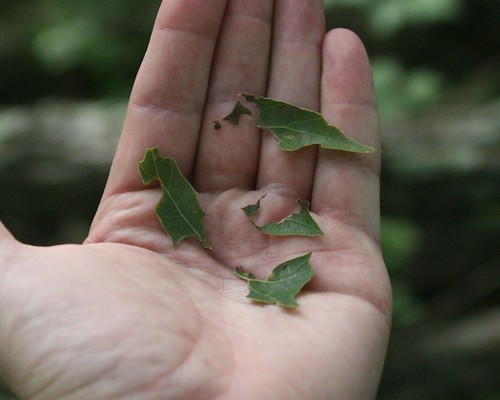
So we focused on that sound and decided that it was like a really, really slow rain. Almost like the rain on the very edge of a storm. Since nothing was wet and it was really more sunny than cloudy, we knew it could not be rain. But that sound of something falling through the leaves was always there.
When we later stopped to examine some caterpillars on the side of the trail, we finally put two and two together. There were lots of caterpillars. At first, I was assuming these were Eastern Tent Caterpillars, but after some searching on Google, a bit of reading (here and here) and some picture comparisons, I have decided that these were Gypsy Moth Caterpillars. The Gypsy Moth is an introduced species in North America. We have Étienne Léopold Trouvelot, and his fleeting interest in entomology, to thank for this.
The caterpillars were happily munching on leaves. Everywhere you looked you saw caterpillars on leaves, and the leaves had holes in them or giant chunks missing from them. And when you examined the trail closely, you noticed bits of green leaves everywhere. Our conclusion was that the massive number of Gypsy Moth Caterpillars were chowing down on the leaves in the canopy, and an endless stream of leaf pieces were falling down to the ground.


Sugarloaf
As I mentioned a few posts back, Tammy and I recently hiked the Sugarloaf-Keyser Run Fire Road-Hogback Mountain loop in Shenandoah. It was a beautiful day, not hot, and very sunny. Here are a few pictures from the hike. The first is a view from Hogback Mountain, looking west over the adjacent valley. The second shows the lush undergrowth of ferns on Hogback Mountain.
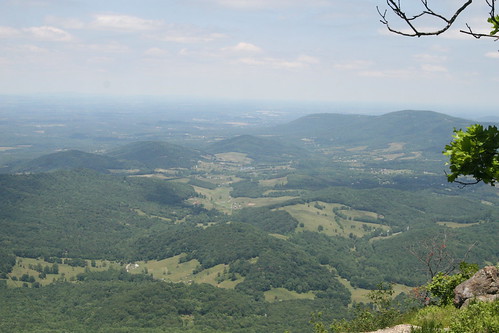
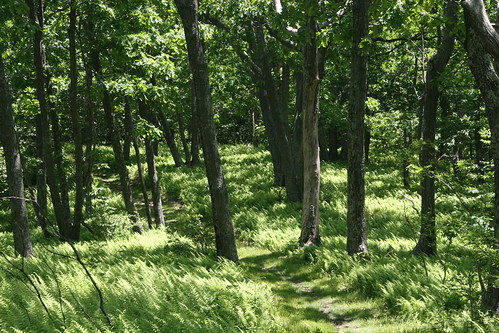


Eastern Gray Squirrel
In addition to the birds, chipmunks and rabbits, I get lots of squirrels in my backyard. While I have successfully arranged my bird feeders so that the squirrels cannot feast directly on the seed, there is still plenty of stuff that falls to the ground to keep them content. On the other hand, I need to do something about my poor excuse for a bluebird house. Having the squirrels turn it on its side so that they can use it as a sunbathing spot is a tad annoying.
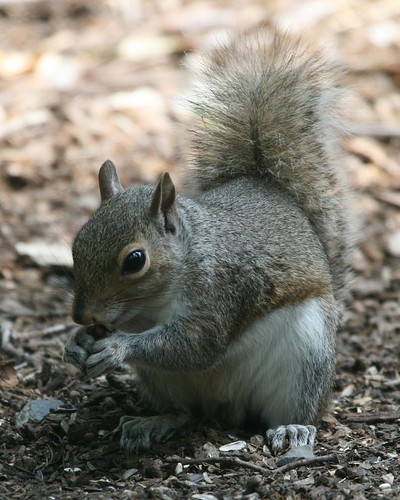
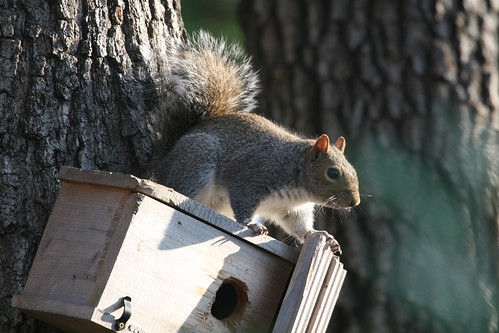


White-breasted Nuthatch
One of my favorite visitors to my bird feeders are White-breasted Nuthatch. A little bit of anthropomorphism goes a long way here: they just seem so laid back and happy. Even better, they can creep head first down trees. I don't know of another bird that has that behavior.
This particular nuthatch decided that the nuts and sunflower seeds in my feeder were too good to pass up. He would grab one and then fly to a nearby tree to eat it. For the sunflower seeds, he would wedge the seed into a crevice in the bark of the tree, and then peck it open with his beak.
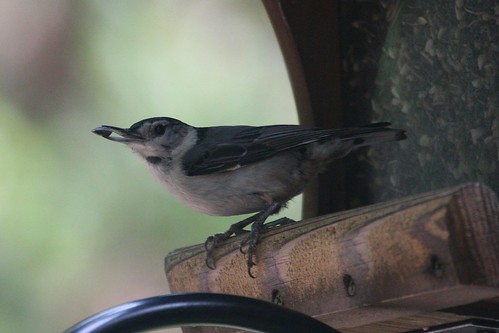
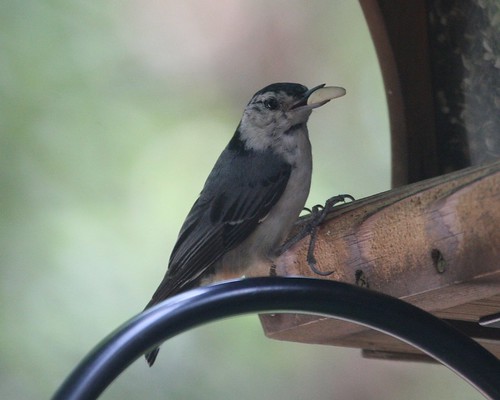
This particular nuthatch decided that the nuts and sunflower seeds in my feeder were too good to pass up. He would grab one and then fly to a nearby tree to eat it. For the sunflower seeds, he would wedge the seed into a crevice in the bark of the tree, and then peck it open with his beak.


Common Grackle
I often hear people who maintain bird feeders in their yard complain if they are attracting grackles instead of the birds that are more visually interesting. Common Grackles are large enough that when they come in for food, they will usually startle any of the smaller song birds that are already there. And then there is the fact that they can eat quite a bit. If you have just a few Common Grackles making visits, it might be manageable, but if a larger flock comes through, they can literally clean your feeders out in a matter of an hour or two.
I will get Common Grackles at my feeders. I usually only see one or two at a time (I think there is a pair nesting somewhere nearby). They will spook most of the other song birds when they arrive, but they come and go enough to allow other birds their chance to feed. And if I see the grackles hanging around constantly, I will let the feeders sit for a few days without food just to get them to move on to another food source.
Despite their annoyances, Common Grackles are still interesting to look at. Their yellow eye really stands out. And while the iridescent coloring on their feathers may look oily, it does give them a touch of color. Here is a photo of a Common Grackle in my backyard.
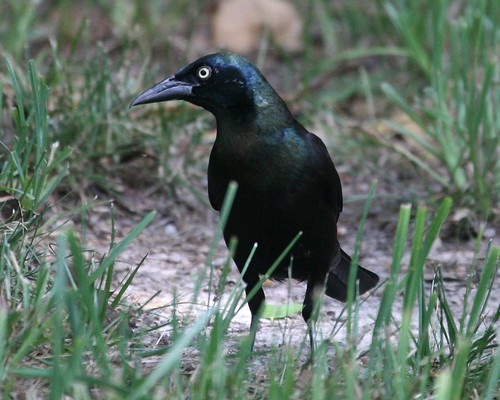
I will get Common Grackles at my feeders. I usually only see one or two at a time (I think there is a pair nesting somewhere nearby). They will spook most of the other song birds when they arrive, but they come and go enough to allow other birds their chance to feed. And if I see the grackles hanging around constantly, I will let the feeders sit for a few days without food just to get them to move on to another food source.
Despite their annoyances, Common Grackles are still interesting to look at. Their yellow eye really stands out. And while the iridescent coloring on their feathers may look oily, it does give them a touch of color. Here is a photo of a Common Grackle in my backyard.

Gray Catbird
As I hinted at yesterday, my backyard is small. And just beyond my fence line there is an interstate highway. But somewhere near my backyard a pair of Gray Catbirds have made a home. Perhaps it is the stand of trees that run between the houses in my neighborhood and the interstate. Or perhaps it is the collection of plants and trees in some neighbor's yard. Whatever the location, the catbirds have made a home, and they have decided that my peanut suet is worth visiting.
One thing I like about the Gray Catbird is that, despite their overall gray appearance, they have this patch of rust color on their undertail coverts. That is a nice dash of color, on an otherwise drab bird. And when you see that color in the field, it can be fulfilling. It is almost like you have not really seen the catbird until you see the flash of that rust color. From these pictures, you can barely get a glimpse of that rust color, on the underside of the tail near the body.
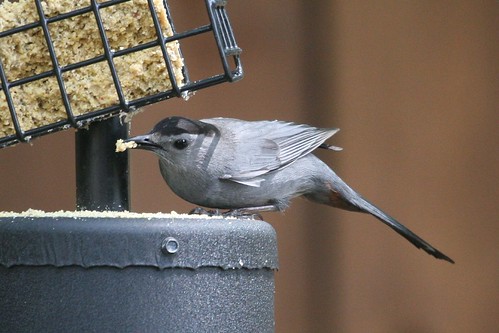
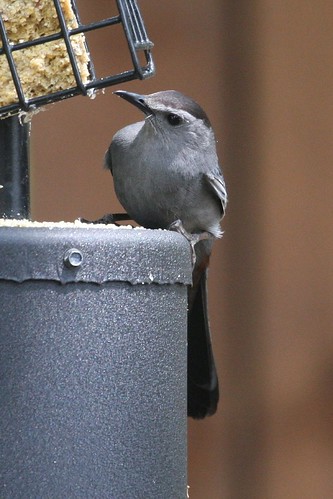
One thing I like about the Gray Catbird is that, despite their overall gray appearance, they have this patch of rust color on their undertail coverts. That is a nice dash of color, on an otherwise drab bird. And when you see that color in the field, it can be fulfilling. It is almost like you have not really seen the catbird until you see the flash of that rust color. From these pictures, you can barely get a glimpse of that rust color, on the underside of the tail near the body.


Carolina Wren
As I mentioned yesterday, a couple weekends back I was just sitting and enjoying the activity in my backyard. I have a tiny yard, with an interstate immediately behind my back fence, so it is always interesting to me to see how many wild things make their home in and around my little slice of home.
On the weekend I took this picture, there were four Carolina Wrens to be seen: two adults and two recently fledged first year birds. The fledglings were following the adults around begging for food and generally making lots of noise. This adult spent time at one of my suet feeders grabbing some nutty goodness.
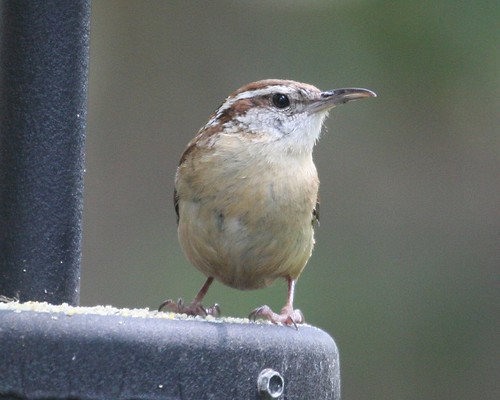
On the weekend I took this picture, there were four Carolina Wrens to be seen: two adults and two recently fledged first year birds. The fledglings were following the adults around begging for food and generally making lots of noise. This adult spent time at one of my suet feeders grabbing some nutty goodness.

Chipmunk Action
A couple weekends back I enjoyed the show that Mother Nature put on in my little backyard. There were lots of birds gathering food for nestlings, or leading fledged birds around and feeding them. There were also plenty of critters out and about. The usual gang of squirrels were out munching, chasing and generally being squirrels. But I also have two chipmunks (I think they are Eastern Chipmunk) that like to gather food in my backyard. Whatever bird seed falls to the ground, the chipmunks are there to get their fair share. They like to poke around and fill their cheeks up with as much food as possible. Then they take it to their stash, unload those cheeks, and come back for some more.
Here are three photos I took of the chipmunk action. The first is with unfilled cheeks ready for some new gathering, the second is an action shot with the chipmunk actively filling up those big cheeks and the third is a somewhat blurry photo of a chipmunk whose pose seems to suggest that they may have over-filled those cheeks just a tad.
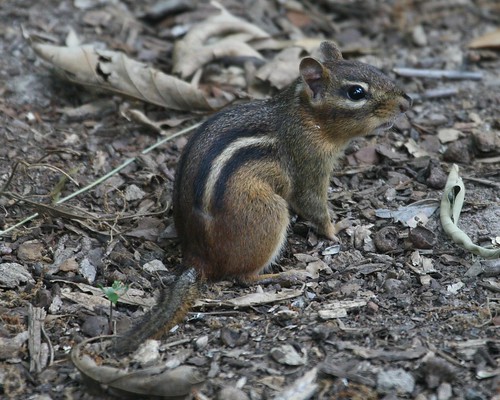
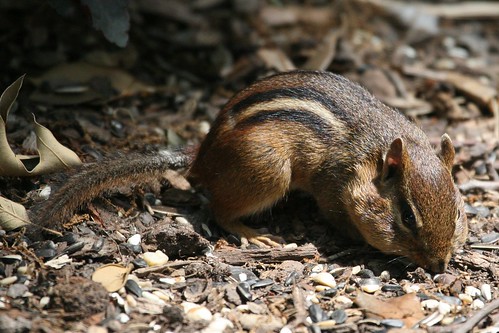
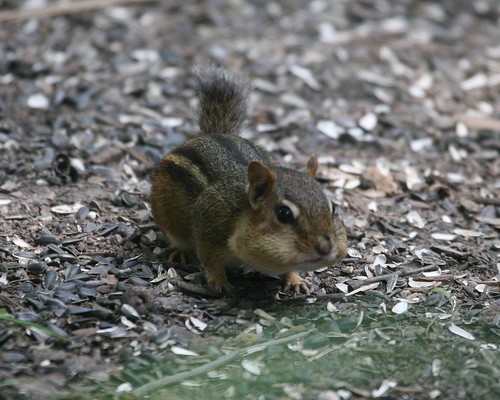
Here are three photos I took of the chipmunk action. The first is with unfilled cheeks ready for some new gathering, the second is an action shot with the chipmunk actively filling up those big cheeks and the third is a somewhat blurry photo of a chipmunk whose pose seems to suggest that they may have over-filled those cheeks just a tad.



A nice day for a hike
Tammy and I went out to Shenandoah for a hike today. We were worried that the heat from a couple days back would persist into the weekend, but the day turned out to be beautiful. It was never really hot at all.
So where did we hike? We went into the northern third of Shenandoah National Park (via route 211 and Sperryville) and hiked a five mile loop. The hike does not really have a name because it is actually a loop formed when you string together about five different trails: Appalachian Trail, Sugarloaf Trail, Pole Bridge Link Trail, Keyser Run Fire Road and Appalachian Trail one more time. One book I have calls it the Sugarloaf-Keyser Run Fire Road-Hogback Loop because of the trails you walk, and the fact that you cross over Hogback Mountain during the last part of the hike. Although the trails are not labeled, you can visualize the hike here via GoogleMaps.
The hike went through good bear territory, but no bears were seen. There were good numbers of the birds that usually hang around in the mountains of Virginia during the summer. There were tons of caterpillars, chomp chomping away at broad leaved trees (it was literally raining leaf bits). One even tried chomp, chomping away on my calf. And did I mention that it was a beautiful day?
[edit: corrected one spelling mistake and one instance of a trail name]
So where did we hike? We went into the northern third of Shenandoah National Park (via route 211 and Sperryville) and hiked a five mile loop. The hike does not really have a name because it is actually a loop formed when you string together about five different trails: Appalachian Trail, Sugarloaf Trail, Pole Bridge Link Trail, Keyser Run Fire Road and Appalachian Trail one more time. One book I have calls it the Sugarloaf-Keyser Run Fire Road-Hogback Loop because of the trails you walk, and the fact that you cross over Hogback Mountain during the last part of the hike. Although the trails are not labeled, you can visualize the hike here via GoogleMaps.
The hike went through good bear territory, but no bears were seen. There were good numbers of the birds that usually hang around in the mountains of Virginia during the summer. There were tons of caterpillars, chomp chomping away at broad leaved trees (it was literally raining leaf bits). One even tried chomp, chomping away on my calf. And did I mention that it was a beautiful day?
[edit: corrected one spelling mistake and one instance of a trail name]
Mating Damselflies
Tammy and I came across this pair of Damselflies mating on a leaf towards the end of our hike at Ragged Mountain Natural Area. This picture isn't sharp, but it is clear enough for you to get the gist of their contortion. Quite an odd shape they make. If you are a sentimentalist, then perhaps you see a heart laying on its side. I am too logical, so all I see are two bugs on a leaf.
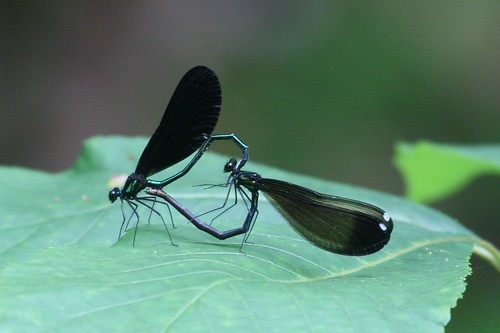

You would be irritable too, if you had an ant crawling on your eye
Towards the end of our hike around the reservoir at Ragged Mountain Natural Area, I noticed a Black Snake sunning itself beside the trail. I immediately seized upon the opportunity for pictures since you just do not find non-venomous snakes posing beside a trail every day.
Of course, later the next week my friend Dennis pointed out that since I was not dead sure that this was a Black Snake, my photographic tom-foolery was more of a gamble than I was admitting. Er...dammit. Mom, you should not pay any attention to Dennis. I think he is just causing trouble :-)
In trying to figure it out now, I cannot really tell whether it is a Black Rat Snake, or an Eastern Racer. Either way, it was not venomous. See Mom? Not venomous!
Anyhow, this snake was sunning itself beside the trail. As I crept closer for a lovely snake portrait, he started flicking his tongue out at me to keep track of where I was. Non-venomous or not, I did not want to get so close that he fled or decided to strike, so my big lens did all the work for me. I am not sure what is more creepy...the snake and its tongue, or the ant crawling on its eye.
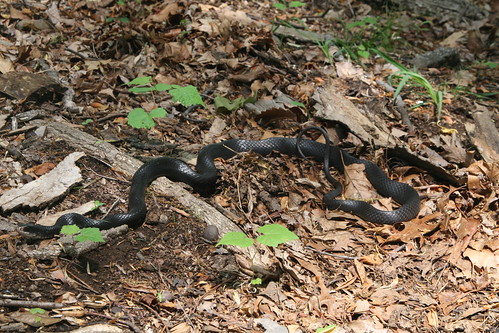
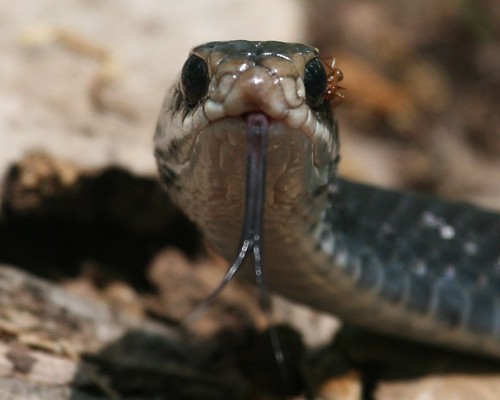
Of course, later the next week my friend Dennis pointed out that since I was not dead sure that this was a Black Snake, my photographic tom-foolery was more of a gamble than I was admitting. Er...dammit. Mom, you should not pay any attention to Dennis. I think he is just causing trouble :-)
In trying to figure it out now, I cannot really tell whether it is a Black Rat Snake, or an Eastern Racer. Either way, it was not venomous. See Mom? Not venomous!
Anyhow, this snake was sunning itself beside the trail. As I crept closer for a lovely snake portrait, he started flicking his tongue out at me to keep track of where I was. Non-venomous or not, I did not want to get so close that he fled or decided to strike, so my big lens did all the work for me. I am not sure what is more creepy...the snake and its tongue, or the ant crawling on its eye.


Weird Building
About halfway through the hike at Ragged Mountain Natural Area, the trail crosses a dam between two sections of the reservoir. On the right side of the dam, there was this stone column with an old building sitting directly atop it. This building had windows, but they were boarded up. There was no way to get to the building unless you wanted to get wet and then climb. I poked around on the web, but could find nothing that described the purpose of this structure. It was kind of surreal, and I joked with Tammy that someone was in the building, peeking out at us through the gaps in the boards.
I did think that there might be some avian residents in that building, but the only birds I saw were two Eastern Phoebe perched in the foliage that was growing on the side of the stone column. Then one of the pair decided that I needed some good pictures, so it flew towards Tammy and I, landed on a sign that was just a few feet away and graciously waited for me to take pictures.
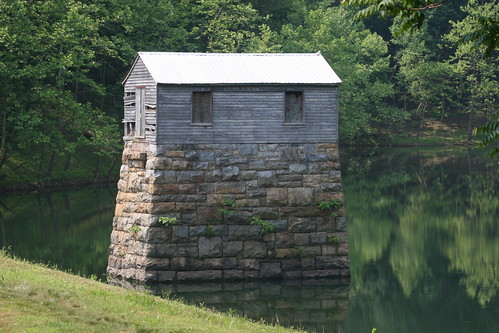

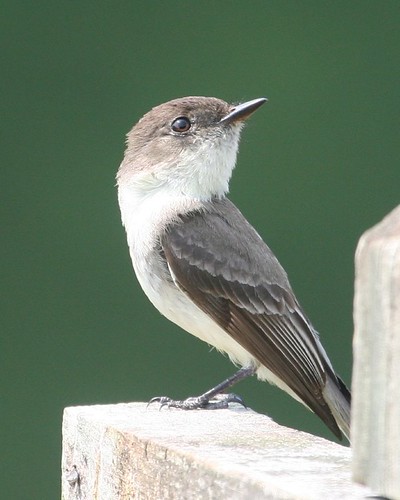
I did think that there might be some avian residents in that building, but the only birds I saw were two Eastern Phoebe perched in the foliage that was growing on the side of the stone column. Then one of the pair decided that I needed some good pictures, so it flew towards Tammy and I, landed on a sign that was just a few feet away and graciously waited for me to take pictures.



Deer in ferns
Two weekends back Tammy and I visited Ragged Mountain Natural Area, in Charlottesville, for a small day hike. The trails are essentially around the Charlottesville Reservoir. One thing that was unique about this park was that no pets are allowed, not even leashed dogs. The reason given was that it increased the wildlife viewing enjoyment for all visitors to the park. I can agree with that logic.
[edit: the trails are not really "in and around" the reservoir...they are really just "around" the reservoir :-)]
On the one hand, I can see how a dog owner would find that rule annoying or unfair. On the other hand, I have been at plenty of parks that allowed leashed dogs but saw dog owners that ignored the part about a leash, and let their dog run free. That can be annoying or unfair to people who are in the park and not particularly interested in interacting with the dog, or would rather the dog did not disturb whatever wildlife there was to view.
Like this deer, chilling out in the ferns.
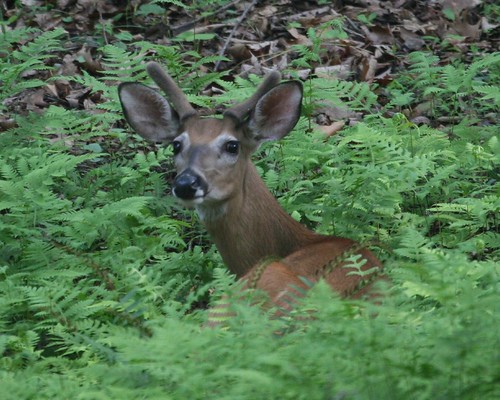
[edit: the trails are not really "in and around" the reservoir...they are really just "around" the reservoir :-)]
On the one hand, I can see how a dog owner would find that rule annoying or unfair. On the other hand, I have been at plenty of parks that allowed leashed dogs but saw dog owners that ignored the part about a leash, and let their dog run free. That can be annoying or unfair to people who are in the park and not particularly interested in interacting with the dog, or would rather the dog did not disturb whatever wildlife there was to view.
Like this deer, chilling out in the ferns.

Tools of the trade
I carry around a lot of gear when I hike or watch birds. For watching birds, I carry binoculars, a field guide, and sometimes a spotting scope attached to a tripod. For photography, I carry my digital camera and one, two or three lenses. I use a Camelbak backpack to carry some of the gear (like lenses and field guides), plus food, water, sunscreen and bug repellent. And finally, I often will carry a GPS with me.
Since I am usually not bushwhacking, the reasons for why I carry a GPS may be a tad vague. Here are my reasons for carrying a GPS, in order of importance to me:
Since I am usually not bushwhacking, the reasons for why I carry a GPS may be a tad vague. Here are my reasons for carrying a GPS, in order of importance to me:
- I am a geek. A GPS falls cleanly under the category of "gadget", and geeks like gadgets. The word "need" does not typically factor into this discussion, however the word "want" is prevalent.
- During the 2007 ABA Conference I attended a lecture that convinced me to start using eBird to track my bird sightings, instead of keeping that data isolated on my PC. Having a GPS makes part of the eBird data entry process much easier.
- I am a geek. Having a GPS lets me do cool things like depicting my hikes on a Google map. Geeks like building web pages, especially if the pages contain cool things like Google maps and GPS tracks.
Baby Rabbit
Last weekend Tammy was helping me with some yard work. Part of the plan was to remove some English Ivy. This is an invasive species that is currently attempting to overgrow anything in its path on one side of my back yard. We had only removed a few feet of it when we noticed that there was something moving around underneath the ivy. Actually, multiple somethings.
We had only considered a couple possible causes for the movement when the answer came hopping out: rabbits. In this case, there were three baby rabbits, all heading in different directions. We ceased our efforts removing the English Ivy and I instead grabbed my camera.
Seeing baby rabbits was a tad ironic. I commented to Tammy on how only that morning I was wondering why I never saw any baby rabbits around. It is not uncommon to see adult rabbits in my yard, or other yards in the neighborhood. And where there are adult rabbits, it is extremely likely that there are also baby rabbits. Mystery solved.
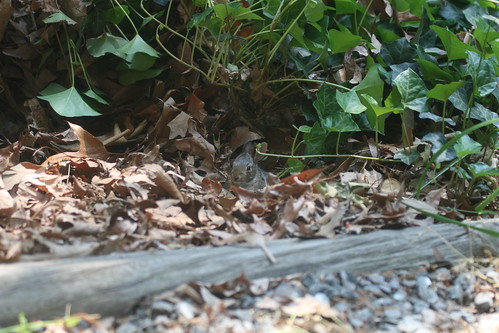
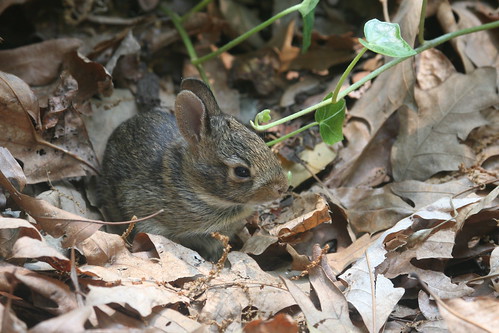
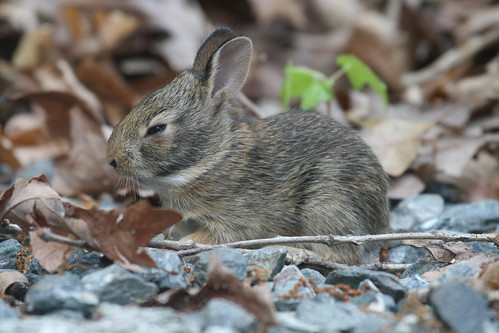
We had only considered a couple possible causes for the movement when the answer came hopping out: rabbits. In this case, there were three baby rabbits, all heading in different directions. We ceased our efforts removing the English Ivy and I instead grabbed my camera.
Seeing baby rabbits was a tad ironic. I commented to Tammy on how only that morning I was wondering why I never saw any baby rabbits around. It is not uncommon to see adult rabbits in my yard, or other yards in the neighborhood. And where there are adult rabbits, it is extremely likely that there are also baby rabbits. Mystery solved.



Smile for the camera
When I got to the end of the River Trail within DGCA, where the boardwalk used to be, I stood for a few minutes to watch and listen. It was during that time that I noticed several dragonflies (I am pretty sure this is not a damselfly...according to Wikipedia, most dragonflies hold their wings horizontally away from the body). To me, they are always interesting to look at, especially up close. This one looks as if he is aware of me and is smiling for the picture I am taking.


Subscribe to:
Posts (Atom)